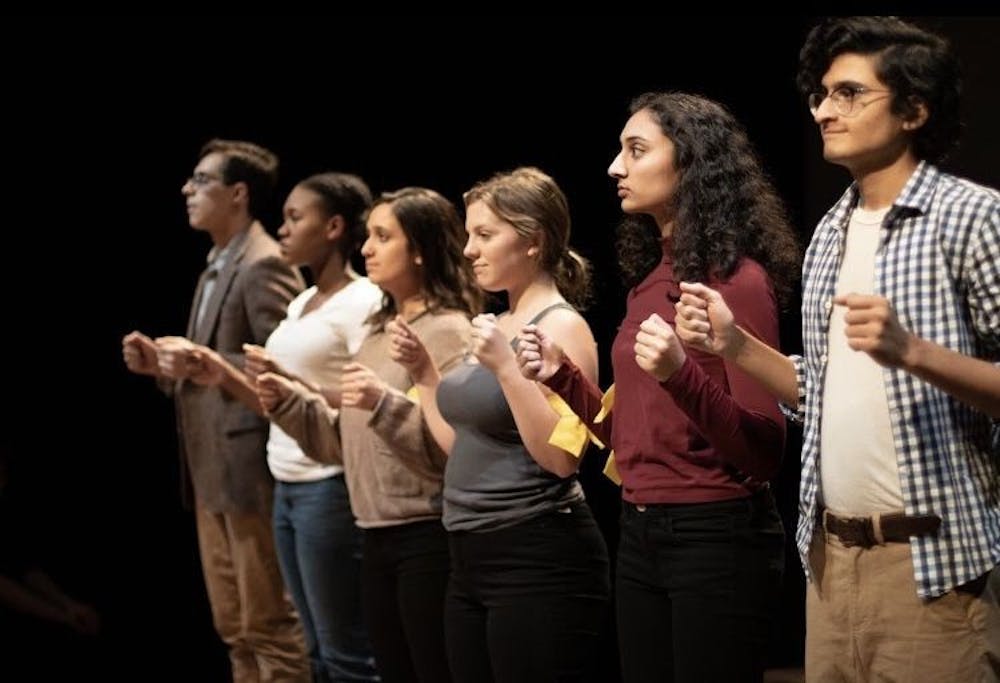This fall, the Barnstormers are celebrating their 100th anniversary with a production of The Laramie Project, the true story of the 1998 hate-crime murder of Matthew Shepard in Laramie, Wyo.
The Laramie Project, written by Moisés Kaufman, follows the aftermath of the murder that brought hate-crime laws (or lack thereof) to headlines across America in 1998. The script is written entirely from interviews that the original cast conducted with the residents of Laramie, making the play feel more like a collection of moments than a scene by scene play. New York-based director Noam Shapiro commented on the structure of the play in an interview with The News-Letter after the show.
“It doesn’t have traditional scenes. It has these moments to show how everyone’s lives are touched by this incident and how each of their lives intersect,” he said.
These mere moments piece together a surprisingly holistic picture of the community. Within minutes of the opening lines, you get a clear image of that quintessential American small town. Like junior Usman Enam, in the role of Greg Pierotti said, “Good people. Lots of space.”
Matthew Shepard was 21 when he was found tied to a fence in critical condition. He had been kidnapped and beaten in what was deemed a hate crime against his sexuality.
Even though Matthew’s murder is a crucial part of the play, The Laramie Project seems to be more interested in examining the aftermath — the anger, pain and healing of the town — rather than the event itself. The play skillfully does this as true opinions bleed through the interviews in fragmented Freudian-slip-like moments of clarity. Since these moments were originally unscripted, there is a real and raw honesty to the nature of the dialogue.
The play opens with all 12 cast members on stage and, for the most part, keeps them on stage for the rest of it. When members of the cast were not speaking, they could be seen sitting on the only (with the exception of a few umbrellas and candles) props for the evening: 12 wooden chairs spaced around the stage.
Shapiro commented on the noticeable lack of sets and props in the play.
“The play is described by the original writers as an actor driven event. It’s all about storytelling. It’s all about simplicity and honesty. It’s all about these characters who are real people. So how do we invite the audience to use their imagination to complete the story?” he said.
The play seemed to be one long choreographed dance; the actors moving around the stage, passing off the spotlight and quietly making clever costume changes that differentiated the 60-plus characters the cast of 12 had to play. The faultless execution of this dance speaks to the excellent stage managing team headed by senior Tori Lyons and the costume design team headed by junior Allison Cuesta and senior Kaley Sten.
This play was certainly a feat for the actors too. The cast was not only charged with the task of distinguishing five (sometimes six) different personas, but were also asked to consider the implications of playing real people. After all, they were acting with the profound idea that this is someone’s story and these are someone’s words. Enam noted that Shapiro often reminded the cast of this.
“Noam always reminded us... do justice to this person because this is an actual person,” he said.
I had this feeling while watching the play that I was being gently coaxed towards some kind of epiphany — some ultimate moral-of-the-story I was supposed to deduce through the culmination of each interview. But to no avail, I found myself wandering in a murky haze of pieces of wisdom. When I asked senior Isabella Altherr, who played Marge among others, what she thought the take-home message was, she said, “I don’t think there is one necessarily... I think of it as an examination of hate and love.”
Altherr makes a good point. The Laramie Project is a true story after all, and true stories rarely boil down to some simple conclusion — it’s their complexity that makes them true.
Altherr continued her assessment.
“Everyone is going to come out differently,” she said. “You want them to leave pricked. You want to prick people with something that’s going to then make them go out into the world and make them have empathy, have love.”
The Laramie Project is an incredible demonstration of the power of art; the collection of moments that made up the play were carefully curated to provoke the audience, whether that was when sophomore Ben Leach as the Baptist Minister eerily said he hoped Matthew had time to regret his gay lifestyle before slipping into a coma, or when sophomore Ritika Kommareddi as Zubaida Ula argued that we have to own that it is “that kind of town” and that this is the kind of country where hateful things can and do happen.
The play is about listening carefully and patiently to everyone’s truth so that you can come to some kind of understanding with hate, find purpose out of loss and be resilient enough to continue to listen.
Before seeing the posters for The Laramie Project around campus, I had not heard of Matthew Shepard or his premature death. Even though his murder had the world in uproar not too long ago, I think his story is unrecognized by many people around my age.
In the same way that shootings and murder and hate are casually dismissed to iPhone notifications, we’ve somehow managed to reduce this play to a unit in high school English. Sure, I can tell you about Orlando or Las Vegas, but will our children be able to? Will even the five-year-olds of today be able to? Or will the world forget those headlines in piles of microfiche as well? Will each generation need their own Matthew Shepard to learn the same lessons as their predecessors?
The Laramie Project may not have saved the world from its forgetful nature, but it certainly affected and still affects everyone it reaches. With every production of The Laramie Project, more of the world is reminded to look down upon hate. This rings especially true for the Barnstormers’ moving performance.
Ultimately, The Laramie Project is about the preservation and persistence of what happened in Laramie in 1998. The story may not reach everyone, but it will transform those it does reach, much like how it transformed the original cast members when they were actually in Laramie conducting the interviews.
Shapiro commented on the play’s message and how he wants it to reach those who watch it.
“One of the main arguments of the play is that hate can happen everywhere,” Shapiro said. “Part of healing is remembering and staying angry and saying this kind of hatred — this kind of violence — is unacceptable. It is who we are as Americans, but it doesn’t have to be. We can become a more perfect union, but it takes some work.”
The Laramie Project will continue its run at the Swirnow Theater in the Mattin Center Friday, Nov. 2; Saturday, Nov. 3; and Sunday Nov. 4.





